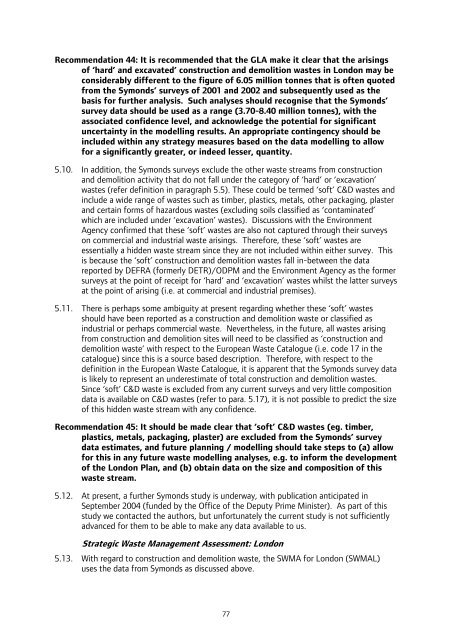London Wider Waste Strategy - London - Greater London Authority
London Wider Waste Strategy - London - Greater London Authority
London Wider Waste Strategy - London - Greater London Authority
Create successful ePaper yourself
Turn your PDF publications into a flip-book with our unique Google optimized e-Paper software.
Recommendation 44: It is recommended that the GLA make it clear that the arisings<br />
of ‘hard’ and excavated’ construction and demolition wastes in <strong>London</strong> may be<br />
considerably different to the figure of 6.05 million tonnes that is often quoted<br />
from the Symonds’ surveys of 2001 and 2002 and subsequently used as the<br />
basis for further analysis. Such analyses should recognise that the Symonds’<br />
survey data should be used as a range (3.70-8.40 million tonnes), with the<br />
associated confidence level, and acknowledge the potential for significant<br />
uncertainty in the modelling results. An appropriate contingency should be<br />
included within any strategy measures based on the data modelling to allow<br />
for a significantly greater, or indeed lesser, quantity.<br />
5.10. In addition, the Symonds surveys exclude the other waste streams from construction<br />
and demolition activity that do not fall under the category of ‘hard’ or ‘excavation’<br />
wastes (refer definition in paragraph 5.5). These could be termed ‘soft’ C&D wastes and<br />
include a wide range of wastes such as timber, plastics, metals, other packaging, plaster<br />
and certain forms of hazardous wastes (excluding soils classified as ‘contaminated’<br />
which are included under ‘excavation’ wastes). Discussions with the Environment<br />
Agency confirmed that these ‘soft’ wastes are also not captured through their surveys<br />
on commercial and industrial waste arisings. Therefore, these ‘soft’ wastes are<br />
essentially a hidden waste stream since they are not included within either survey. This<br />
is because the ‘soft’ construction and demolition wastes fall in-between the data<br />
reported by DEFRA (formerly DETR)/ODPM and the Environment Agency as the former<br />
surveys at the point of receipt for ‘hard’ and ‘excavation’ wastes whilst the latter surveys<br />
at the point of arising (i.e. at commercial and industrial premises).<br />
5.11. There is perhaps some ambiguity at present regarding whether these ‘soft’ wastes<br />
should have been reported as a construction and demolition waste or classified as<br />
industrial or perhaps commercial waste. Nevertheless, in the future, all wastes arising<br />
from construction and demolition sites will need to be classified as ‘construction and<br />
demolition waste’ with respect to the European <strong>Waste</strong> Catalogue (i.e. code 17 in the<br />
catalogue) since this is a source based description. Therefore, with respect to the<br />
definition in the European <strong>Waste</strong> Catalogue, it is apparent that the Symonds survey data<br />
is likely to represent an underestimate of total construction and demolition wastes.<br />
Since ‘soft’ C&D waste is excluded from any current surveys and very little composition<br />
data is available on C&D wastes (refer to para. 5.17), it is not possible to predict the size<br />
of this hidden waste stream with any confidence.<br />
Recommendation 45: It should be made clear that ‘soft’ C&D wastes (eg. timber,<br />
plastics, metals, packaging, plaster) are excluded from the Symonds’ survey<br />
data estimates, and future planning / modelling should take steps to (a) allow<br />
for this in any future waste modelling analyses, e.g. to inform the development<br />
of the <strong>London</strong> Plan, and (b) obtain data on the size and composition of this<br />
waste stream.<br />
5.12. At present, a further Symonds study is underway, with publication anticipated in<br />
September 2004 (funded by the Office of the Deputy Prime Minister). As part of this<br />
study we contacted the authors, but unfortunately the current study is not sufficiently<br />
advanced for them to be able to make any data available to us.<br />
Strategic <strong>Waste</strong> Management Assessment: <strong>London</strong><br />
5.13. With regard to construction and demolition waste, the SWMA for <strong>London</strong> (SWMAL)<br />
uses the data from Symonds as discussed above.<br />
77
















